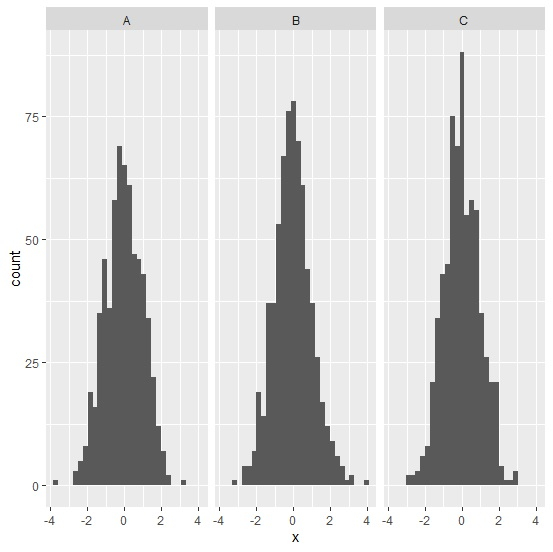
 Data Structure
Data Structure Networking
Networking RDBMS
RDBMS Operating System
Operating System Java
Java MS Excel
MS Excel iOS
iOS HTML
HTML CSS
CSS Android
Android Python
Python C Programming
C Programming C++
C++ C#
C# MongoDB
MongoDB MySQL
MySQL Javascript
Javascript PHP
PHP
- Selected Reading
- UPSC IAS Exams Notes
- Developer's Best Practices
- Questions and Answers
- Effective Resume Writing
- HR Interview Questions
- Computer Glossary
- Who is Who
How to create facetted histograms using ggplot2 in R?
The facetted histograms are the separated histograms created for different categories in a single plot window. We can follow the below steps to create such type of histograms using ggplot2 −
- First of all, create the data frame.
- Load the ggplot2 package and create facetted histogram with the help of facet_grid function of ggplot2 package.
Create the data frame
Let's create a data frame as shown below −
Group<-sample(LETTERS[1:3],2000,replace=TRUE) x<-rnorm(2000) df<-data.frame(Group,x) head(df,30)
On executing, the above script generates the below output(this output will vary on your system due to randomization) −
Group x 1 A -0.15109174 2 B 0.79993882 3 C 0.08982681 4 B -0.14506660 5 A -0.11787381 6 C -0.96427342 7 A 1.11687020 8 B -1.07769076 9 C -1.01850658 10 B 0.24430195 11 B -0.15510646 12 A 0.13364920 13 A -0.15671764 14 A -1.96636140 15 B 1.72444566 16 B 0.74713059 17 C -0.98136868 18 C -1.93135045 19 C -0.51990385 20 B -2.15635971 21 B 0.35730736 22 C -0.16965592 23 A 0.82810224 24 B -1.58918990 25 C 0.32902104 26 C -0.08942102 27 B 0.31243311 28 B -0.01585389 29 B -0.78921478 30 A -1.27632182
Creating the facetted histograms
Loading ggplot2 package and creating facetted histograms for values in Group column −
Group<-sample(LETTERS[1:3],2000,replace=TRUE) x<-rnorm(2000) df<-data.frame(Group,x) library(ggplot2) ggplot(df,aes(x))+geom_histogram(bins=30)+facet_grid(.~Group)
Output


Advertisements
